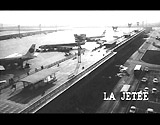
|
La Jetée (1962, Fr.) (aka
The Jetty, or The Pier)
In writer/director Chris Marker's landmark, eloquent,
short, philosophical sci-fi French featurette film that was part
of the Left Bank artistic movement in France; the cautionary science-fiction
tale was composed entirely of B/W still photograph frames
("un photo-roman") and voice-over narration
(by Jean Negroni in French, or James Kirk in English).
The challenging "photo-novel" was
set in a post-apocalyptic, dystopic time after WWIII. It told about
a group of experimental scientists in bombed-out Paris who attempted
to send a man (haunted by his past) back in time to his life before
the devastating war, to find the key (a source of energy) to continuing
life into the future.
[Note: The influential, narrated slide-show film
was remade as Terry Gilliam's 12 Monkeys (1995), while it
paid homage to Last Year in Marienbad (1961, Fr.) and
Hitchcock's Vertigo (1958).]
- the opening title cards (voice-over by Narrator
(Jean Negroni or James Kirk)) provided a brief, post-title credits
prologue: "This is the story of a man, marked by an image of his childhood. The violent
scene that upset him, and whose meaning he was to grasp only years
later, happened on the main jetty at Orly, the Paris Airport sometime
before the outbreak of World War III"
- the film's opening sequence provided
an unexplained, vague, haunted and fateful pre-war boyhood memory
that occurred at the Orly Airport on a Sunday with his parents while
watching the departing planes
- a young boy remembered the face of
a beautiful Woman (Helene Chatelain) at the end of the jetty: ("Nothing
sorts out memories from ordinary moments. Later on they do claim remembrance
when they show their scars. That face he had seen was to be the only
peacetime image to survive the war. Had he really seen it? Or had he
invented that tender moment to prop up the madness to come?")
- the boy was shocked and horrified
when a man fell dead and his body crumbled, as he was
running toward the Woman on the airport's pier (jetty) or rooftop
viewing platform; the images blurred due to fear and then faded to
black: ("Later, he knew he had seen a man die")
- the confounding plot told about a nuclear global holocaust
(WW III) that hit the city of Paris, with many photos of the hellscape
of vast devastation and radioactive wasteland: ("Above ground,
Paris, as most of the world, was uninhabitable, riddled with radioactivity.
The victors stood guard over an empire of rats")
- surviving mad scientists (the victorious
commanders or jailers), who ominously whispered in German, were headed
up by a "Dr. Frankenstein" Experimenter
(Jacques Ledoux), operating under the Palais de Chaillot; they conducted
time-travel experiments on "guinea pigs" (the victims or
prisoners) in a network of filthy underground bunkers, galleries
and caves, in an attempt to solve society's collective problems,
or otherwise mankind was doomed; their efforts to have some subjects
travel to the past were disappointing, and led to many failed
attempts for those who died or lost their minds and went mad
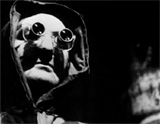
The Victorious Survivors Stood Guard Over Prisoners
|
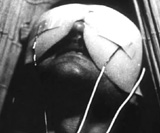
|
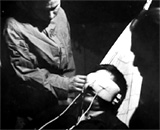
|
|
Prisoners Were Subjected to Painful Experiments
- Lying in a Hammock with Wired Blinders Over Eyes
|
- the subterranean experimenters proposed to select
a new "guinea pig" - an unnamed frightened prisoner-volunteer
(Davos Hanich); the narrator identified him as the film's
main character; the Head Experimenter believed that "the only
hope for survival lay in Time"; by a time travel mission,
it might be possible to rescue the Present by finding food, medicine,
and sources of energy: ("Send emissaries
into Time, to summon the Past and the Future to the aid of the Present");
it was considered very risky and too much of a shock to "wake
up in another age" (and) "to be born again as an adult"
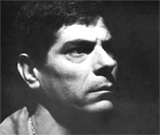
|

|
|
The Man - Time Traveler Prisoner-Volunteer (Davos
Hanich)
|
- the volunteer-prisoner had a single,
fixated memory from his pre-war childhood; he was selected because
of the searing and vibrant image he had maintained from his past
in his brain: ("The inventors were now concentrating on men given
to very strong mental images. If they were able to conceive or dream
another time, perhaps they would be able to live in it"); the Man was
selected "from among a thousand for his obsession with an image from
the past"; although the Man suffered from numerous injections, he
did not die or go mad; the auditory soundtrack played sounds of a rapid heartbeat
- on the 10th day of experimental time-travel, "images
began to ooze, like confessions"; in the Man's head, he visualized
images of the past that formed (similar to scar wounds); images included
a peacetime morning, a peacetime bedroom and a "real" bedroom, "real"
children, "real" birds, "real" cats, and
"real" graves; they were labeled "real"
by the Narrator, although they were only imagined or "unreal" projections
that were made up, or that were elements of dreams
- on the 16th day of time-travel, the Man was on the
empty jetty at Orly airport; amongst other images of happiness, he
saw a girl who could be the one he sought - the girl he passed on
the jetty, and the girl who smiled at him from an automobile; other
images appeared in the "museum" of his fragmented memory
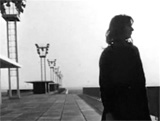
The Girl He Passed on the Jetty
|
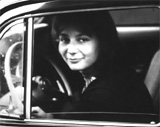
The Girl Smiling at Him From an Automobile
|
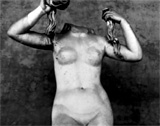
Fragmented Memories and Other Images in the "Museum" of His Mind
|
- on the 30th day of his time travel to the
pre-war past, the volunteer recognized and met the mysterious Woman
(the one on the airport jetty) in an affluent area, filled
with fabulous materials (glass, plastic, terry cloth); but then when
he came out of his trance, she was gone; however, he was sent back
out to pick up her "trail" once more - "Time rolls back again, the moment
returns"; he spoke to her and she welcomed him "without surprise"
- the Narrator described their first meeting in detail: ("This
time, he is close to her, he speaks to her. She welcomes him without
surprise. They are without memories, without plans. Time builds itself
painlessly around them. Their only landmarks are the flavor of the
moment they are living and the markings on the walls"); later on,
they entered a garden, and were seen together as a couple; she asked
him about his combat necklace (the one he wore at the start of a
future war), and he was forced to invent an "explanation"
- while looking at a cut slice of the trunk of a giant
redwood tree (marked with historical dates), the
Man from the future showed the Woman the time from the future that
he had come from by pointing to one of the tree ring circles outside
the circumference of the trunk (a point beyond the tree): "This is
where I come from..."
[Note: This scene paid homage to Hitchcock's similar sequence in Vertigo
(1958), although circumstances were now reversed. In the 1958
film, Madeleine (Kim Novak) showed Scotty (James Stewart) the location
on rings of a sequoia trunk marking the past when she was born and
died as Carlotta Valdez.]
- the experiment paused when he fell back, exhausted,
as another "wave of Time washes over him - the result of another
injection perhaps"; she basked in the sunlight and slept, and
as he sat next to her and observed her, he thought to himself that
he might have returned to her and found her dead; he was relieved
when she woke up from an "unreachable country"; soon, he
became obsessed with her and often stared at her
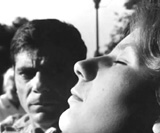
|
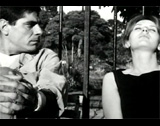
|
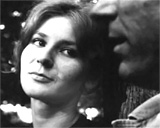
An Unbroken Trust Began to Develop
|
|
The Man Was Relieved that the Woman Woke Up After Sleeping in the Sun
|
- the Narrator described how he eventually developed
a relationship of trust and love with her: "Is it the
same day? He doesn't know. They shall go on like this, on countless
walks in which an unspoken trust, an unadulterated trust will grow
between them, without memories or plans. Up to the moment where he
feels - ahead of them - a barrier"
- the first set of experiments came to an end, and
he would soon have to begin a new series of
tests or experiences with her; the next dreamy
narration implied that the images of them together in the past were all
fictitious: "...he
would meet her at different times. Sometimes, he finds her in front of
their markings. She welcomes him in a simple way. She calls him her
Ghost. One day, she seems frightened. One day,
she leans toward him. As for him, he never knows whether he moves
toward her, whether he is driven. Whether he has made it up, or whether
he is only dreaming"
- in the film's most memorable sole moment (accompanied by
the deafening sound of birds), the Woman was asleep and unmoving in bed -
but then in a single, startling and effective moving image (the film's sole moment of animation!)
- she dreamily opened her eyes from deep sleep and looked directly at the camera and blinked
- around the 50th day, the Man and the Woman from his
past visited a museum filled with dead "timeless animals" (stuffed,
ageless, immobile or taxidermied giraffes, elephants, rhinos, zebras,
hippos, a whale, bobcats, exotic birds and other species, etc.); the
Narrator described how the couple was indistinguishable from the
preserved or frozen animals, as static or still images: "Now
the aim is perfectly adjusted. Thrown at the right moment,
he may stay there and move without effort. She too seems tamed. She
accepts, as a natural phenomenon, the ways of this visitor who comes
and goes, who exists, talks, laughs with her, stops talking, listens
to her, then disappears"
- however, "Once back in the experiment room, he knew
something was different. The camp leader was there"; it was decided
that after all of the "brilliant tests" in the Past, he would now
be shipped off into the Future; acc. to the Narrator: "The meeting
at the museum had been the last"
- also, during the Man's brief trip to a better-protected
far future, after some painful trials, he eventually "caught some
waves of the world to come. He went through a brand new planet. Paris
rebuilt, ten thousand incomprehensible avenues"; while
the time-traveling Man was wearing sunglasses, he
had a "brief encounter" with a group of strange, expressionless,
shadowy alienoid beings (with a third eye on their foreheads in the
form of a medallion-object) who were awaiting his arrival; they were
descendants of the survivors of his own age, who provided him with
the technology to help regenerate, rebuild and save civilization;
they gave him a "power unit strong enough to put all human industry
back into motion," before
the gates to the Future were then closed
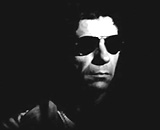
The Man Wearing Sunglasses During A Trip to Far Future
|
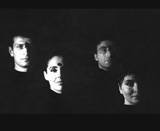
Four Strange Alienoid Beings in the Future
|
- after being transferred to another part of the camp,
the Man knew that his time was limited; although he was offered
a place in the Future, he chose to return to the Past: "He
knew that his jailers would not spare him. He had been a tool in
their hands, his childhood image had been used as bait to condition
him. He had lived up to their expectations, he had played his part.
Now he only waited to be liquidated with, somewhere inside him,
the memory of a twice-lived fragment of time. And deep in this
limbo, he received a message from the people of the world to come.
They too traveled through Time, and more easily. Now they were
there, ready to accept him as one of their own. But he had a different
request: rather than this pacified future, he wanted to be returned
to the world of his childhood and to this woman who was perhaps
waiting for him"
- as a reward for saving the world, the Man was sent
back to his past - to a haunting childhood memory on
the airport jetee-platform on a warm pre-war Sunday afternoon; in
a "confused way," he expected to see himself as the child he
had been on the jetty platform watching the airplanes; but first
of all, he wanted to see the Woman's face at the end of the jetty
- in the evocative, paradoxical plot twist conclusion (as the images sped
up), history repeated itself; as he desperately ran forward toward the awaiting Woman at the end
of the jetty, he was shot dead (and frozen in mid-air) by one of
his subterranean captors; it was a realization (and his pre-determined
Fate) that he could not escape his temporal bonds and escape to
the idyllic past of his untrustworthy memories:
- "He ran toward her. And when he recognized the man who had trailed him since
the underground camp, he understood there was no way to escape Time, and that this moment he had
been granted to watch as a child, which had never ceased to obsess him, was the moment
of his own death"
- he discovered that he was the dying man he saw as a child, who was killed by a man
from the post-apocalyptic "present"
|


The Face of The Woman (Helene Chatelain) on the Airport's
Viewing Platform
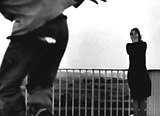
The Haunting Boyhood Memory of a Sudden Death of a Man
on an Airport Jetty That Was Also Viewed by a Woman

Views of the Post-Apocalyptic Hellscape of Paris After WWIII

The Head "Dr. Frankenstein" Experimenter
(Jacques Ledoux) - A Mad Scientist

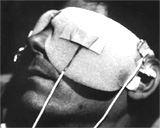
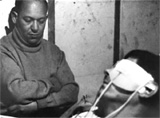
Painful Time-Travel Experiments on The Man

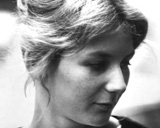
Meeting The Woman (Helene Chatelain) on the 30th Day of the Time-Travel
Trial
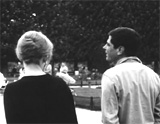
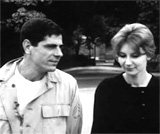
Entering a Garden Together
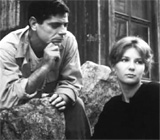
The Couple

The Man Pointing Out to the Woman a Giant Redwood
Tree's Ring Circles, Some Representing the Future
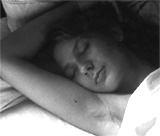

The Woman Awakened and Looked Into the Camera - The
Only Moving Image in the Entire Film
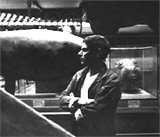
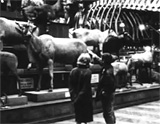
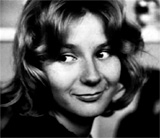
Together with the Woman In a Museum of Timeless Animals



A Return to the Man's Childhood's Haunting Memory - With a Plot Twist
Revelation
|























